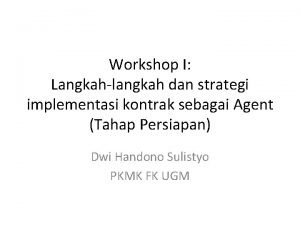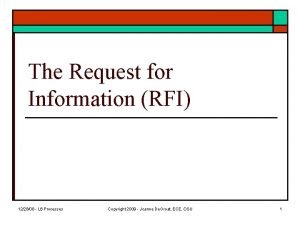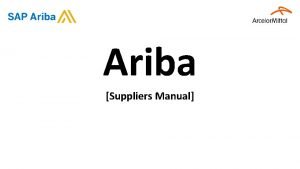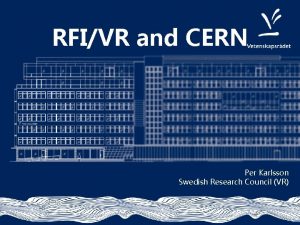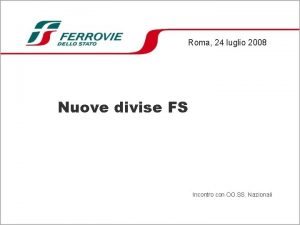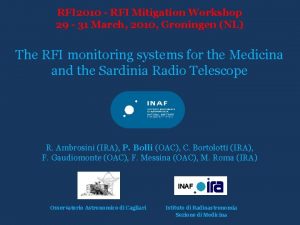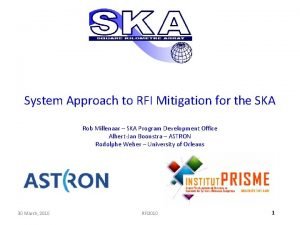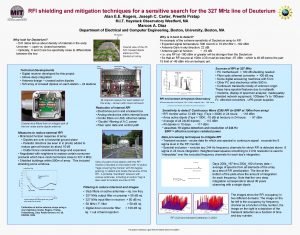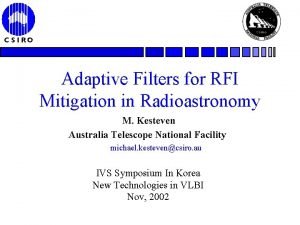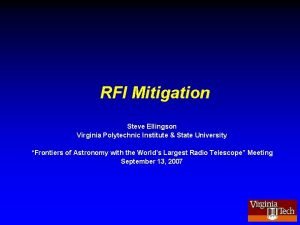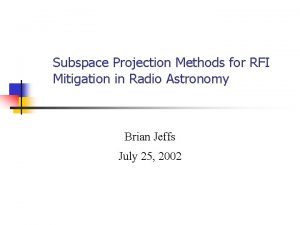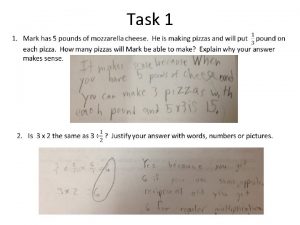RFI Mitigation in AIPS The New Task UVRFI














- Slides: 14

RFI Mitigation in AIPS. The New Task UVRFI L. Kogan, F. Owen National Radio Astronomy. Observatory Socorro, NM USA March 2010 RFI 2010

Visibility expression in the setting of RFIs moving with constant velocities relatively the array Given correlator outputs during the solution interval and considering the all RFI amplitudes are constant within of the solution interval, our goal is to find the value of the source visibility for the solution interval! March 2010 RFI 2010

The Athreya’s approach to the problem: The circular model Ramana Athreya, APJ, 696, 885 -890, May 2009 Consider RFI which includes one group moving with constant velocity (in particular located at the Earth or one satellite). Assuming constant amplitude inside of the solution interval, the trajectory of the correlator output in the complex plane is the circle with radius equal to RFI amplitude. The center coordinates are Re, Im of the source visibility. Fitting the 3 parameters: radius of the circle, and the two coordinates of the circle center, the aquired coordinates of the circle center are the solution for the source visibility without RFI March 2010 RFI 2010

The visibility spectrum for one baseline of Rupen’s data (L band) March 2010 RFI 2010

One of the best “circle” March 2010 RFI 2010

The new AIPS task UVRFI uses the 2 algorithms: 1. ‘CIRC’ a l’a Athrea The spiral with 4 unknown parameters: initial radius, linear increment of the radius, 2 coordinates of the center is fitted to the data. The 2 coordinates of the center are used as a solution for the free RFI visibility. 2. ‘CEXP’ The model is represented by the sum of several spectral components with complex amplitude. The simple version of the Hogbom clean algorithm (complex Fourier transform, complex solution and complex “PSF”) is used to subtract the complex components. Final solution is the value of the cleaned Fourier transform at zero frequency. The subtraction is not carried out for the component at zero frequency to prevent the subtraction of the signal itself. This rule is canceled for the very high channel amplitude in comparison with other channels. March 2010 RFI 2010

The actual shape of the “circles”. L-band data (given by M. Rupen). March 2010 RFI 2010

The visibility spectrum for one baseline of Rupen’s data (L band) The averaged output March 2010 RFI 2010 The UVRFI output

The image of 3 C 345 using Rupen’s data (L band) The averaged output March 2010 RFI 2010 The UVRFI output

The actual shape of the “circles”. 4 -band data (given by B. Cotton). March 2010 RFI 2010

The visibility spectrum for one baseline of Cotton’s data (4 band) The averaged output March 2010 RFI 2010 The UVRFI output

The images using the Cotton’s data (4 band) The averaged output March 2010 RFI 2010 The UVRFI output

Self averaging of the visibilities in the process of imaging Therefore the effect of self averaging of RFI may not limited by the correlator averaging interval (as Athrea declares) but rather by the time interval where both U and V can be considered constant! March 2010 RFI 2010

Conclusions The new AIPS task UVRFI uses the two algorithms to mitigate RFI. • CIRC function based on modification of Ramana Athrea algorithm fits a spiral into the observed visibility curve in the complex plane • CEXP function subtracts the complex exponents representing RFI, using a simple CLEAN algorithm at the Fourier plane • The second algorithm demonstrates better result for the two data I used and allows to mitigate more than one sources of RFI (ground, satellites) • The utility of RFI mitigation algorithms is complicated by the non-circular nature of the RFI in the sample datasets. • In some cases, RFI may be self averaged during imaging March 2010 RFI 2010
 Aip animal
Aip animal Contoh rfi proyek
Contoh rfi proyek Rfi request for information
Rfi request for information Ariba manual
Ariba manual Rfi meaning
Rfi meaning H tlps-#iqrms. g i e iz 1 luv_$:rfi ? v r cw9r-qca
H tlps-#iqrms. g i e iz 1 luv_$:rfi ? v r cw9r-qca Rfi filter for garage door opener
Rfi filter for garage door opener Divisa rfi
Divisa rfi Rfi group
Rfi group Rfi process flow chart
Rfi process flow chart Rfi workflow
Rfi workflow Tiered task bias task
Tiered task bias task Somerset mold remediation
Somerset mold remediation Bad news mitigation
Bad news mitigation Mitigation strategy examples
Mitigation strategy examples

